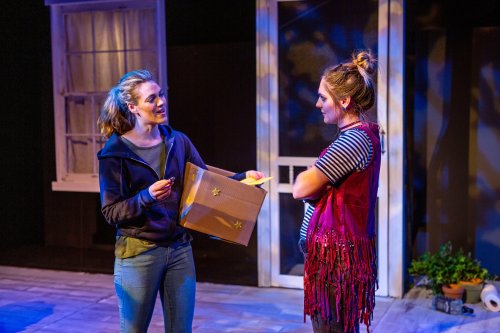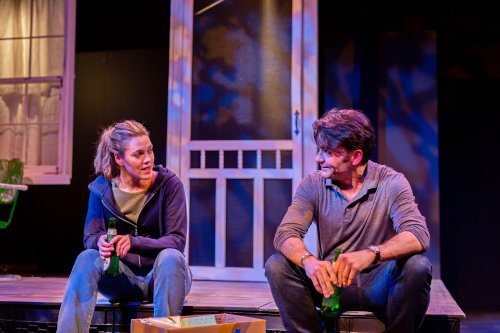Chasing the River
Released from prison, a young woman returns to the home where she killed the father who raped her in this well-intentioned but less-than-gripping drama.

Christine Elise Perry as Kat and Caroline Orlando as Beth in a scene from Jean Dobie Giebel’s “Chasing the River” at Chain Theatre (Photo credit: Matt Wells)
[avatar user=”Mark Dundas Wood” size=”96″ align=”left”]Mark Dundas Wood, Critic[/avatar]
Plays dealing with sexual abuse of children present challenges to theater companies, particularly when—like Jean Dobie Giebel’s Chasing the River (directed by Ella Jane New for Chain Theatre)—they feature a parent as perpetrator. Giebel’s protagonist is a young woman who went to prison for manslaughter following the killing of the father who raped her.
The main action takes place after Kat (Christina Elise Perry) has served her time following a voluntary manslaughter conviction. She returns to her childhood home in the Pennsylvania town where the killing took place. Here, she encounters people from her past: her ex-boyfriend Sam (David Rey), her mother Margaret (Robyne Parrish), and her runaway younger sister Beth (Caroline Orlando). She also encounters ghosts. The most prominent, unsurprisingly, is Nathaniel (David Wenzel), the dangerous, alcohol-fueled father she killed. There’s also her tough but benign Aunt Adelaide (Sara Thigpen). Woven into the main action are episodes from Kat’s early years. Giebel doesn’t have different players portray the younger characters in these flashbacks. Rather, the same actors play their characters at various ages.
The subject matter of Chasing the River is, of course, viable, but the play is not as nuanced and insightful as one would hope—nor is it particularly gripping. Sometimes the action feels stagey, and at other times it seems undercooked.

Christine Elise Perry as Kat and David Rey as Sam in a scene from Jean Dobie Giebel’s “Chasing the River” at Chain Theatre (Photo credit: Matt Wells)
Particularly problematic is the role of Nathaniel who is written and acted quite one-dimensionally. True, Giebel offers at least one surprising aspect of the character: We learn that he wanted a sports-playing boy-child, not daughters, and that he treated the tomboyish Kat (then called “Katie”) as a substitute for a son. We learn that he was able to gain Katie’s trust, which he then insidiously betrayed. We never wonder, however, whether he is anything other than an unrelenting nightmare of a person. There are scenes in which we see him being pleasant to Katie, but his bullying monstrousness seems always apparent. Most creeps—even the alcoholic ones—manage to hide their ugly sides now and then.
Perry makes Kat a sympathetic character, though whether she is fully believable as a young woman who has endured rape/incest, a miscarriage of justice, and a prison term is arguable. The role may not be perfectly written, but it provides a rich opportunity for an actor. It seems Perry could have gone deeper into the role, showing us colors we didn’t expect.
Kat’s objective, apparently, is to come back to her unhappy childhood home to try to make some sense of the past, but that’s a rather loose aspiration. The character is asked early on why she has returned, and she claims she doesn’t know. Part of the reason for the return appears to be a burning curiosity about how much the people around her knew of or suspected the sexual dimensions of the hell her father was putting her through and, more pointedly, why—if they suspected—they didn’t come to her aid. The first half of the play seems to be largely about her rekindled alliance with Sam, but after the (rather unnecessary) intermission, the focus shifts to her relationship with sister Beth. (Orlando proves a good choice to play Beth in at least one regard: she and Perry bear a strong resemblance to each other and are thoroughly believable as siblings.)

David Wenzel as Nathaniel and Christine Elise Perry as Kat in a scene from Jean Dobie Giebel’s “Chasing the River” at Chain Theatre (Photo credit: Matt Wells)
The rest of the cast does a respectable job. Adelaide is probably the most individuated and memorable character. She’s a dollar-store philosopher: blowsy, averse to nonsense, and fairly smug. Thigpen makes her a colorful presence. As Margaret, the mother, Parrish shows some dramatic character contrasts. In the present-day scenes, she is much more openhearted than in the flashbacks, where she is withdrawn and sullen. Sam is a relatively thankless role, but Rey does just fine with what he is given.
Raye Levine Spielberg’s scenic design—focused on the front porch of the humble family house—is appropriately simple. Lighting designer Michael Abrams helps the audience differentiate between scenes set in the present and memories brought to life. There is no costume designer credited, but the clothing the characters wear seems suitable for working-class people living somewhere in the overlap between suburban and rural America.
Chasing the River (through February 29, 2020)
Chain Theatre, 312 West 36th Street, in Manhattan
For tickets, call 866-811-4111 or visit http://www.chaintheatre.org
Running time: one hour and 45 minutes including one intermission






Leave a comment